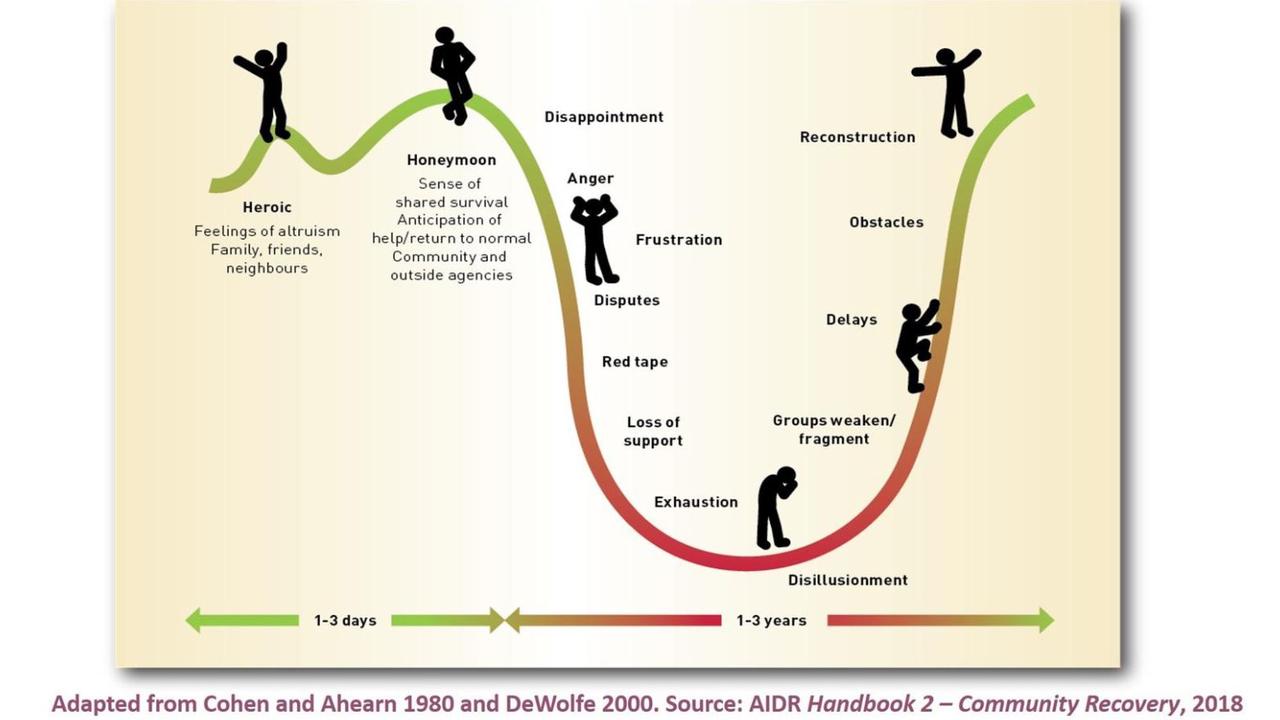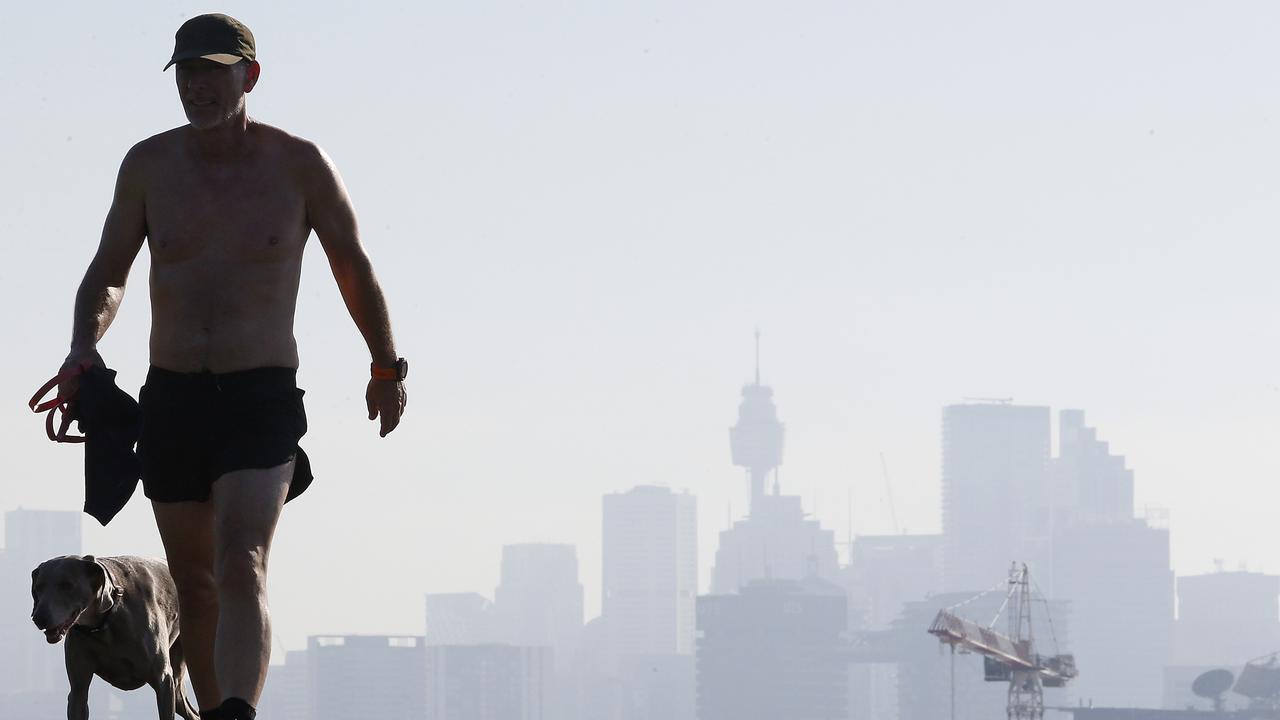We react but don’t recover – disaster rebuilding needs a wake up call
We manage disasters well but have a long road to understanding recovery – experts warn Australia needs to get better at rebuilding communities after crisis
Australia knows how to respond to crisis effectively but doesn’t properly understand recovery, and risks alienating communities unless the rebuilding takes a more strategic and long-term approach.
Anne Leadbeater has a very unique insight into life after disaster. She has worked as a recovery consultant following fires, floods, earthquakes but it was her experience fighting the Black Saturday fires as a Kinglake resident — and in helping co-ordinate the fall out — that helped guide her research into rebuilding.
“We need to plan for recovery in the way we plan for response,” she told The Sunday Telegraph.

“We are not seeing that same level of strategic consideration and preparation for what the issues and challenges will be.
“We wouldn’t respond to a disaster without a clear plan or approach and without qualified and appropriate equipment — it would be irresponsible.
“We haven’t evolved the recovery conversation to that same level of preparation and planning and that is the opportunity going forward.”
Small, regional towns are often the ones most impacted by bushfires but they are also the ones that have a strong sense of community. In the Victorian town of Strathewen, badly affected by the Black Saturday fires, a group banded together to create mosaic letterboxes for people whose home had been burnt down.

“People had no way of receiving communication because their letterboxes burnt down and it became the first marker,” Melbourne University’s Professor Lisa Gibbs said.
Professor Gibbs lead a study into the Black Saturday fires and said the recent fires showed how far Australia had come.
“It is immediately obvious how much better our communication and warning systems are compared to what we had. It could have been so much worse. We have learnt a lot but there is still a lot of education we could be doing.”
Ms Leadbeater, who is on the Australian Red Cross Bushfires Advisory Panel, said locals risked being steamrolled by government services and large organisations.
“People are grieving for their future — and it takes longer than we think. We are talking between two and five years for a community to be at a point where the disaster doesn’t take up all of their efforts and energy,” she said.

“In our collective grief and concern we have this heartfelt desire for people to be OK but there is a risk we can drive the pace of recovery and prioritise recovery in ways that don’t actually reflect what is needed and what would be the choices of the community.
“People’s ability to contribute to their own recovery still exists and we don’t do them any service by coming in over the top and saying ‘we are here now — we know what you need’. Often the community will end up with a recovery it doesn’t even recognise and ends up with a community that loses its shared values.”

UNICEF’s Nicole Breeze, director of Australian programs, said “building back better’’ depends on recognising true recovery often doesn’t start until a good 12 months after the event.
“UNICEF responds to more than 300 human emergencies each year and what is essential is that rapid response is accompanied by long term support,” she said.
Andrew Colvin, co-ordinator and head of the National Bushfire Recovery Agency, recognised different levels of government can complicate disaster recovery: “It will be the National Bushfire Relief Agency’s job to cut through red tape to ensure the right help gets to the right people at the right time.”

There is only twisted, charred metal left in Katrina Condie’s Conjola Park’s property.
The family home they built 25 years ago was destroyed in the fires on New Year’s Eve.
She has spent the month since trying to detangle the red tape between different levels of government: “It is frustrating, trying to deal with government red tape around block clearing and stabilisation. I go round in circles talking to government and then insurance and then the bank.
“We just want to get on with it. I understand these things take time but we don’t have time because time is money.”

DONATE TO THE CONDIE FAMILY HERE
The Condies have been offered accommodation in a local holiday house, which she said had been wonderful for recovery, and received a $10,000 Red Cross grant.
Ms Condie said every cent, including the car insurance from her burnt-out vehicle, was going back into rebuilding the house.

Ninety homes were destroyed in the small community but locals already have plans to rebuild together.
“We have become closer as a community. I had one set of neighbours and we used to wave at, now when we see each other we hug and cry,” Ms Condie said.
HOW TO GET CHILDREN PAST BUSHFIRE TRAUMA
CHILDREN in fire affected areas went back to school this week but it was a very different experience with temporary classrooms, borrowed school shoes and donated books.
For these students school isn’t the only thing that has changed. Acting out, anxiety and even bullying has been shown to rise after disasters with traumatised children often externalising behaviours.
But a Save The Children program, which was developed especially for distressed children after Hurricane Katrina, will start next month for students in fire zones in order to help schoolchildren process their ordeal.
“After Hurricane Katrina we identified there was a really significant response to the emergency itself but a gap in terms of looking after children’s long term mental health,” Save The Children’s Matt Gardiner, Director of Australian Services, said.

“We focus on event but in terms of children‘s understanding and development they can’t comprehend something on this scale,” he said.
Also rolled out after the New Zealand Christchurch earthquakes the Journey of Hope program will be offered to bushfire-affected schools in NSW and Victoria, reaching 4000 students.
Kicked off with a grant from the Lego Group’s Emergency Relief Fund the program has reached 100,000 children around the world and a study showed it significantly increased resilience and coping skills for children and reduced psychological stress.

Mr Gardiner said the charity’s experiences following Japanese disasters had shown them a different way of helping children cope after a crisis.
“The traditional means of addressing trauma that psychology has been using forever is to, most often in a group setting, go through the event itself and try to dissect feelings and emotions people have,” he said.
“If a child or an adult was incredibly impacted you would go through the event and attribute feelings and how it came about.”
The trauma counsellor said recent work had shown a better approach was helping children identify their feelings, recognise triggers and build resilience.
“This program is very careful not to talk about or describe the event, which is what we have learnt in trauma response in the field. Instead, usually within a class setting we have a fun activity based on interaction and building coping skills with their peers. It is focused on how to identify emotions and how to express themselves with some coaching around healthy emotional states,” he said.

He said that bullying often occurred after a disaster.
“It is a normal thing that follows both an individual trauma and a community trauma – people cope differently and when children see difference they call it out.
“That happens frequently so we help children understand how their peers respond differently and what to do and respond supportively rather than see the difference as weird.”
The program will initially be rolled out in disadvantaged, fire affected areas as people who are already in stressful situations are more vulnerable to further distress.
Mother of six Jessica from Tumbarumba, near the NSW/Victoria border, was evacuated for nearly three weeks after the fires with her town losing all power.
“It was very, very long and a bit stressful, initially the kids were scared we weren’t going to have a house to go back to and then after the first week they were just getting on each others’ nerves.”
Jessica said the program would help fill in some gaps in services.
“You would have to travel for hours to find a community that wasn't affected, we don’t have local services and services elsewhere are taken up,” she said.
“One of my kids especially was hit really hard but even with the other kids you don’t know because they don’t have the words to tell you.”
With around 10,000 children in NSW, Victoria and South Australia affected by the fires the charity hopes to expand the program further, contingent on funding.
For children under five a separate program helps parents and carers work through their trauma and gives them tools to help their children.
“One of the things we know with trauma and with a lot of mood disorders is that it is contagious and as a parent you can’t be as responsive as you want to be if you are going through your own trauma,” Mr Gardiner said.
“We give them better awareness and some skills to regulate their own emotions and also how to identify and respond to their children and their emotions.”
If you would like to donate to Save The Children’s bushfire appeal you can here
Originally published as We react but don’t recover – disaster rebuilding needs a wake up call


